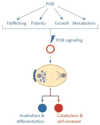Lymphocyte Fate and Metabolism: A Clonal Balancing Act
- PMID: 28818395
- PMCID: PMC5696055
- DOI: 10.1016/j.tcb.2017.07.005
Lymphocyte Fate and Metabolism: A Clonal Balancing Act
Abstract
Activated lymphocytes perform a clonal balancing act, yielding a daughter cell that differentiates owing to intense PI3K signaling, alongside a self-renewing sibling cell with blunted anabolic signaling. Divergent cellular anabolism versus catabolism is emerging as a feature of several developmental and regenerative paradigms. Metabolism can dictate cell fate, in part, because lineage-specific regulators are embedded in the circuitry of conserved metabolic switches. Unequal transmission of PI3K signaling during regenerative divisions is reminiscent of compartmentalized PI3K activity during directed motility or polarized information flow in non-dividing cells. The diverse roles of PI3K pathways in membrane traffic, cell polarity, metabolism, and gene expression may have converged to instruct sibling cell feast and famine, thereby enabling clonal differentiation alongside self-renewal.
Keywords: PI3K; anabolism; asymmetric; catabolism; mTOR; self-renewal.
Copyright © 2017 Elsevier Ltd. All rights reserved.
Figures




References
-
- Reiner SL, Adams WC. Lymphocyte fate specification as a deterministic but highly plastic process. Nature reviews Immunology. 2014;14:699–704. - PubMed
Publication types
MeSH terms
Substances
Grants and funding
LinkOut - more resources
Full Text Sources
Other Literature Sources
Miscellaneous

